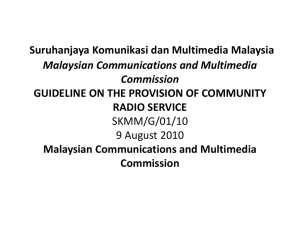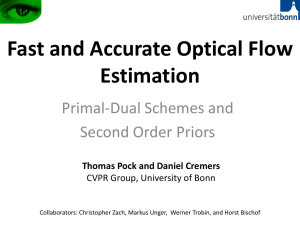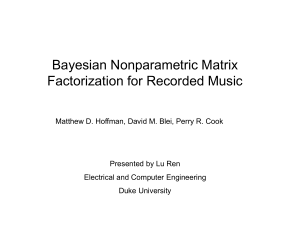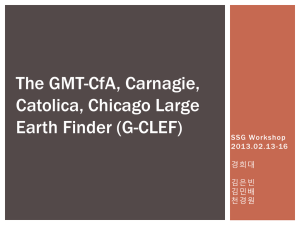Posselt Derek
advertisement
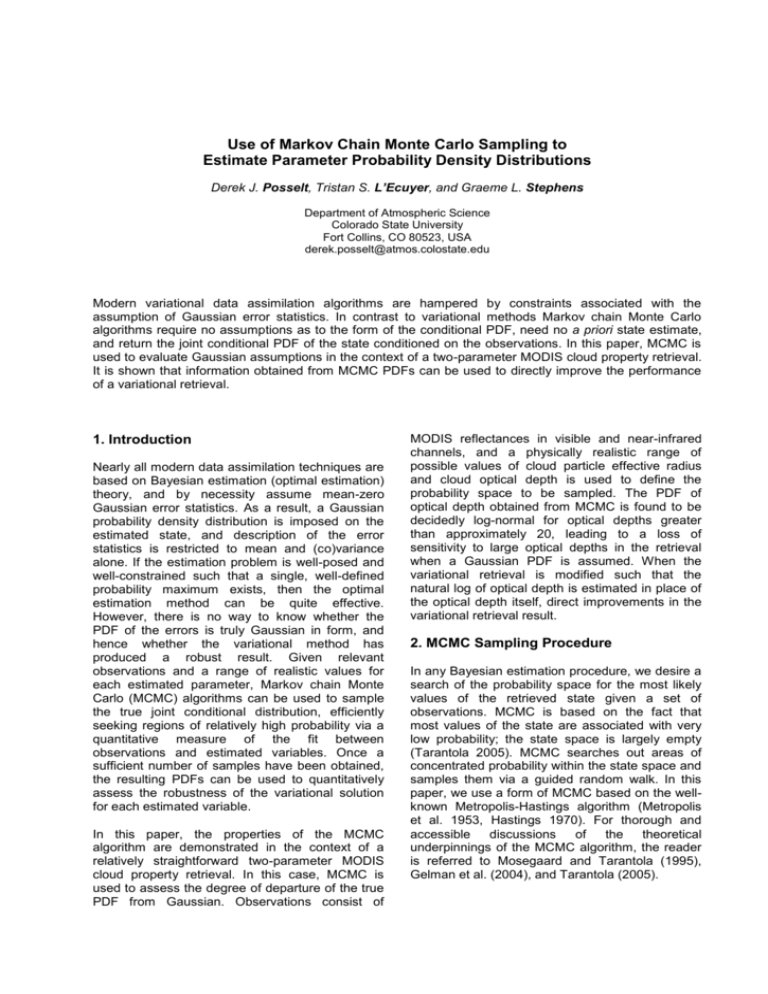
Use of Markov Chain Monte Carlo Sampling to Estimate Parameter Probability Density Distributions Derek J. Posselt, Tristan S. L’Ecuyer, and Graeme L. Stephens Department of Atmospheric Science Colorado State University Fort Collins, CO 80523, USA derek.posselt@atmos.colostate.edu Modern variational data assimilation algorithms are hampered by constraints associated with the assumption of Gaussian error statistics. In contrast to variational methods Markov chain Monte Carlo algorithms require no assumptions as to the form of the conditional PDF, need no a priori state estimate, and return the joint conditional PDF of the state conditioned on the observations. In this paper, MCMC is used to evaluate Gaussian assumptions in the context of a two-parameter MODIS cloud property retrieval. It is shown that information obtained from MCMC PDFs can be used to directly improve the performance of a variational retrieval. 1. Introduction Nearly all modern data assimilation techniques are based on Bayesian estimation (optimal estimation) theory, and by necessity assume mean-zero Gaussian error statistics. As a result, a Gaussian probability density distribution is imposed on the estimated state, and description of the error statistics is restricted to mean and (co)variance alone. If the estimation problem is well-posed and well-constrained such that a single, well-defined probability maximum exists, then the optimal estimation method can be quite effective. However, there is no way to know whether the PDF of the errors is truly Gaussian in form, and hence whether the variational method has produced a robust result. Given relevant observations and a range of realistic values for each estimated parameter, Markov chain Monte Carlo (MCMC) algorithms can be used to sample the true joint conditional distribution, efficiently seeking regions of relatively high probability via a quantitative measure of the fit between observations and estimated variables. Once a sufficient number of samples have been obtained, the resulting PDFs can be used to quantitatively assess the robustness of the variational solution for each estimated variable. In this paper, the properties of the MCMC algorithm are demonstrated in the context of a relatively straightforward two-parameter MODIS cloud property retrieval. In this case, MCMC is used to assess the degree of departure of the true PDF from Gaussian. Observations consist of MODIS reflectances in visible and near-infrared channels, and a physically realistic range of possible values of cloud particle effective radius and cloud optical depth is used to define the probability space to be sampled. The PDF of optical depth obtained from MCMC is found to be decidedly log-normal for optical depths greater than approximately 20, leading to a loss of sensitivity to large optical depths in the retrieval when a Gaussian PDF is assumed. When the variational retrieval is modified such that the natural log of optical depth is estimated in place of the optical depth itself, direct improvements in the variational retrieval result. 2. MCMC Sampling Procedure In any Bayesian estimation procedure, we desire a search of the probability space for the most likely values of the retrieved state given a set of observations. MCMC is based on the fact that most values of the state are associated with very low probability; the state space is largely empty (Tarantola 2005). MCMC searches out areas of concentrated probability within the state space and samples them via a guided random walk. In this paper, we use a form of MCMC based on the wellknown Metropolis-Hastings algorithm (Metropolis et al. 1953, Hastings 1970). For thorough and accessible discussions of the theoretical underpinnings of the MCMC algorithm, the reader is referred to Mosegaard and Tarantola (1995), Gelman et al. (2004), and Tarantola (2005). run for many successive iterations to allow a thorough sampling of the state space, and a posterior probability density distribution is built for each state parameter from the set of accepted states. An illustration of the convergence of the MCMC algorithm to sampling a stationary distribution is presented in figure 1, which depicts samples obtained from the joint PDF of optical depth and effective radius for pixel (19,19) in the MODIS dataset. It is clear that by as early as 200 samples (Fig. 1a), the PDF is starting to take shape, and that by 10,000 samples (Fig. 1d) the PDF is wellcharacterized. For comparison, the PDF obtained from 1,000,000 samples (Fig. 1e) is contrasted with the result of brute force sampling across the range of values for optical depth and effective radius (Fig. 1f). Brute force sampling was performed by stepping through the range of optical depth and effective radius in increments of 0.1, running the forward radiative transfer model, and computing the likelihood function in each iteration. Though the optical depth PDF has a slightly longer tail in the MCMC result, the PDFs are remarkably similar, demonstrating the effectiveness of MCMC in characterizing the true PDF. Figure 1: Example of convergence of MCMC to sampling a stationary distribution. Progressively greater numbers of samples are shown in (a) through (e), while the result of brute force integration in increments of 0.1 in optical depth and effective radius is shown in (f) for comparison. In practice, the Markov chain is started from a set of state parameters drawn from a bounded Uniform PDF, with bounds set to physically realistic values for each estimated parameter.* In each MCMC search iteration a randomly-chosen state parameter is perturbed and a new value within the allowable range is generated. The model is then run using the new parameter values and new values of the state are generated and compared with the observations via a predetermined likelihood function. The new state is accepted and stored if the new likelihood exceeds the old, or if the new value is sufficiently close to the previous value as determined in a partially probabilistic manner. This probabilistic acceptance is important in that it (1) encourages the algorithm to sample regions close to areas of relatively large probability, and (2) allows the algorithm to leave a local probability maximum. The MCMC algorithm is * The bounded uniform PDF is appropriate in the retrieval context as it represents the minimum possible prior information on the state, and assumes no other information aside from a reasonable range of values for each retrieved parameter. 3. MCMC Applied to MODIS Cloud Property Retrieval In this section, we present results from a comparison between a MCMC and a variational retrieval of cloud optical depth and effective radius from measured reflectances in 0.64 and 2.13 micron wavelengths. The scene of interest was observed at approximately 2130 UTC on 4 July 2001 by the MODIS instrument on EOS Terra, and consisted of low broken stratus and stratocumulus clouds over the northeast Pacific Ocean. The Radiant radiative transfer model (Gabriel et al. 2005) was used to compute forward reflectances from cloud optical depth and effective radius, and errors in each MODIS channel were specified as 5% of the observed reflectance. The variational retrieval follows the optimal estimation framework outlined in Rodgers (2000). A priori optical depth and effective radius were set equal to physically reasonable values for liquid stratus clouds; 20 and 10 microns, respectively. Error variances of 225 and 100 m2 were assigned to these a priori values for the purpose of spanning ranges of optical depth and effective radius typically observed in nature; 0 to 100 and 0 to 60, respectively. It was assumed for simplicity that observation errors were uncorrelated between channels, as were a priori errors. In the following analysis, we compare variational (Gaussian) and MCMC retrieved PDFs for selected pixels. The fact that the MCMC algorithm returned lognormal PDFs for and re suggests that the variational retrieval could be improved by retrieving the natural log of optical depth. A log-normal PDF is thus imposed on , and because the natural log of a log-normally distributed random variable is distributed Gaussian, we can retain the Gaussian variational framework. The only fundamental change is that the Jacobian is computed with respect to variations in the natural log of and re, and the a priori error variance is specified such that the variance of the log-normal a priori distributions for and re is identical to the variance of the Gaussian a priori PDFs. Figure 2: PDFs from MCMC retrieval of optical depth for (a) a 5 x 5 pixel region, and (b) and (c) two selected pixels from this region. The uniform a priori is shown in light gray, the posterior MCMC PDF is shown in black, and the Gaussian variational PDF in dashed gray. The two pixels shown in greater detail are outlined in thick dashed gray in the 5 x 5 matrix. The total integrated absolute difference between MCMC and Gaussian PDFs is printed in the upper right hand corner of each pixel in (a). Retrieved optical depth and effective radius PDFs from both MCMC and variational techniques are compared in figure 2 for a 5x5 pixel subregion that contains both cloudy and clear pixels. The MCMC PDFs are uniformly mono-modal, and PDFs in pixels in which optical depth is less than 20 appear to be well-characterized by a Gaussian distribution. However, as optical depths increase beyond 20, the optical depth PDFs increasingly depart from Gaussian. In fact, for optical depths greater than 50 (pixels (15,19), (16,19) and (16,20)), the MCMC PDF exhibits little departure from the a priori bounded uniform PDF, indicating that the observations have contributed very little information to the solution. For pixels with optical depths between 20 and 50, the MCMC PDFs appear to be log-normal in shape, with a mode that is increasingly displaced from the variational mode with increasing optical depth. To more clearly demonstrate the similarities and differences between variational and MCMC retrieved PDFs, and re from two selected pixels are shown enlarged at the right side of figure 2. Figures 2b and 2c depict optical depth PDFs for pixels with relatively low (10-15) and relatively high ( 40) optical depth respectively. In these figures it can be seen that the observations contribute enough information to effectively constrain the retrieval for low optical depths (Fig. 2c); the MCMC and variational solutions are nearly identical in this case. However, with increasing optical depth (Fig. 2b), the solutions diverge, and the variational PDF provides a poor approximation to the solution. Comparison of retrieved optical depth from the original variational retrieval, and the variational retrieval of log- (not shown) demonstrates restored sensitivity to larger values of optical depth for the log- retrieval. In addition, integrated differences between variational and MCMC PDFs are reduced by approximately 40% in regions where optical depth is greater than 30. 4. Conclusions Given a set of observations and a model that relates observations to a set of desired state variables, Markov chain Monte Carlo methods can be used to generate the full joint conditional posterior PDF for the unknown state. In this paper we have used MCMC to obtain PDFs for optical depth and effective radius retrieved from visible and near-infrared MODIS reflectances. The results have been used to evaluate a more traditional variational retrieval of and re that assumes Gaussian error characteristics. It was found that assumption of Gaussian errors leads to a loss of sensitivity in the retrieval to optical depths greater than 30. Comparison of MCMC PDFs with those assumed in the variational retrieval revealed that the PDFs for optical depth were log-normal in form. When the variational retrieval is modified such that the natural log of is retrieved, the sensitivity to large optical depths is restored and values of optical depth up to 50 can be obtained. In addition, assumption of log-normal errors leads to better fit between the assumed PDFs in the variational retrieval and those obtained from MCMC. The relatively straightforward application of the MCMC algorithm in this paper demonstrates the utility of MCMC for evaluating variational estimation methods. In principle, the technique can be extended to more complex estimation problems, especially ones in which we expect that the PDFs may be highly non-Gaussian. If computational difficulties can be overcome, MCMC also has obvious applications for evaluating the Gaussian assumptions used in atmospheric data assimilation systems. Because MCMC is already tractable for small-dimensional parameter spaces (e.g., < 20), initial experiments involving estimation of the PDFs of semi-empirical numerical model physics parameters are currently underway. It can be shown that these PDFs contain information on the sensitivity of the model evolution to specified constant parameters, and could provide guidance on ways to reduce model error. Acknowledgments This work was funded by NASA NMP contract NAS100072. Mick Christi, Philip Gabriel, and Kyle Leesman helpfully fielded questions about the Radiant radiative transfer model, while Steve Cooper assisted in estimating the errors associated with neglecting absorption in the near-infrared. Tomi Vukicevic and Richard Davis provided guidance on the proper application of the MCMC algorithm. References Gabriel, P. M., M. Christi, and G. L. Stephens: Calculation of Jacobians for Inverse Radiative Transfer: An Efficient Hybrid Method. J. Quant. Spect. and Rad. Trans. In Press, 2005. Gelman, A., J. B. Carlin, H. S. Stern, and D. B. Rubin: Bayesian Data Analysis, 2nd Ed., Chapman and Hall/CRC, New York, NY, 2004. Hastings, W.: Monte Carlo sampling methods using Markov chains and their applications. Biometrica, 57, 97-109, 1970. Metropolis, N., A. W. Rosenbluth, M. N. Rosenbluth, A. H. Teller, and E. Teller: Equations of state on fast computing machines. J. Chemical Physics, 21, 1087-1092, 1953. Mosegaard, K., and A. Tarantola: Monte Carlo sampling of solutions to inverse problems. J. Geophys. Res., 100, 12,431-12,447, 1995. Rodgers, C. D.: Inverse Methods for Atmospheric Sounding, Theory and Practice, World Scientific, Singapore, 2000. Tarantola, A.: Inverse Problem Theory and Methods for Model Parameter Estimation, SIAM, Philadelphia, PA, 2005
